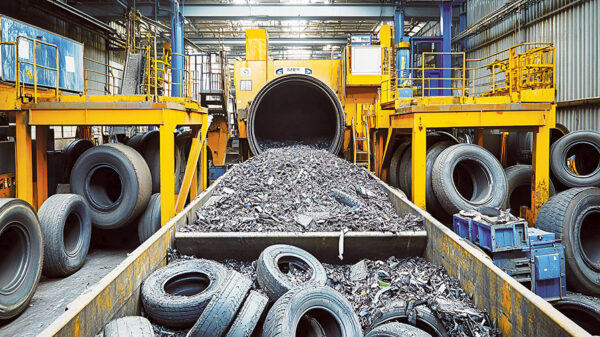by DONNA CURRIE
ECO Green was founded in 2010 by Brad Swenson, Jon Porter and Andres Salazar. It all began when Salazar brokered a deal to sell a shredder overseas, but the deal went sour. Swenson and Porter helped him work things out. They then decided to start a business together. It was a great idea and ECO Green was started.
The first iteration of the company involved U.S. engineers designing rubber recycling machinery that was built in China. After two years, they realized they needed to do something different – something that was “game changing.”
In 2012-2013, the manufacturing was moved from China to Salt Lake, Utah. “There was no way for us to produce a quality machine in China,” Swenson said. Salt Lake’s major industry is aerospace, so there’s no shortage of engineers and precision manufacturing, making it ideal for making high quality tire shredders.
“Everyone in the tire recycling machinery market had come from another industry,” Swenson said. Machinery that was originally designed to handle metal or plastic was being modified and sold for tire recycling. Those machines worked well enough, but Swenson and his partners decided to do something different. They brought in engineers who designed machines from the ground up for tire recycling. “That was a huge advantage,” Swenson said, and it led to a patent for their primary shredder, the ECO Green Giant.
Swenson explained that tire recycling is a brutal environment, since tires are designed to be nearly indestructible and resistant to a blow out while traveling at high speeds. “Engineers had to take that into account.”
Their secondary shredder removes steel from tire material, producing some of the cleanest steel recovered from tires that you’ll find. It also uses 40 percent less energy than other shredders, and since it operates at a slower speed, it results in less wear on the knives so maintenance costs are lower.
To add to their lineup, the company purchased a technology called “Crumb Buster” from an inventor. After a few tweaks, that machine is the highest capacity rubber powdering machine on the market. The company also manufactures a granulator, so every aspect of tire recycling is covered.
While the majority of recycled tires used to end up going to concrete plants as tire derived fuel, Swenson estimated that 50 percent of the material is now being used for other purposes. “People are finding more value added ways to sell their products,” he said, including thermoplastics that can be found in many products.
While there are good markets for the processed tire material, the recyclers still face challenges. Transportation can be expensive, so processing needs to be economical for recycling to make sense. For those who are thinking about getting into tire recycling, the initial costs are high, particularly in small cities where there may not be enough volume to support a tire shredder. “They can’t justify the investment for the amount of tires they have.” ECO Green’s quest for economical tire recycling will help those cities process tires affordably while also making a positive impact on the environment.
Swenson said that their business model is unique, with three separate prongs. First, the engineers and designers have new theories, but they have to prove them in the real world. Second is the assembly of the machinery in their U.S. manufacturing plant. Last is the knowledge of what to do with the rubber after it is processed, because ECO Green doesn’t just sell equipment and walk away – they also help their customers find ways to sell the material they process. Sometimes that means they won’t make a sale when a potential customer doesn’t have enough material to process. In that case, ECO Green may introduce them to someone who has already made the investment in equipment, so the two companies can work together.
From its humble beginnings with three owners and overseas manufacturing, the company has grown into a new 25,000 sq.ft. manufacturing facility. They have 20 full time employees that build $10 million of new equipment each year and they ship to 5 of the 7 continents.
Looking forward, Swenson believes that there is a lot of change happening in the tire recycling business. “This industry is very young,” he said. The machinery can still be improved to reduce the cost of recycling while producing even better material. “It’s very exciting.”
Published in the June 2019 Edition







